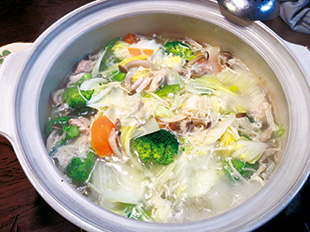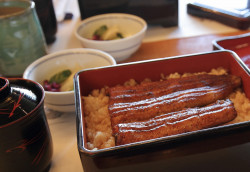
Originally published on metropolis.co.jp on January 2014

One of the most comforting Japanese meals in winter is nabe. Thankfully, the hot pot dishes are easy to assemble and whatever you find in your refrigerator is often enough to get you cooking. Everything is made in a single pot, so post-meal cleanup is a breeze. These are also fun meals for entertaining at home with family and friends, which will warm up quickly once the pot starts bubbling and you crack open a bottle of sake. Add nabe to your kitchen repertoire and it will change your life.
There are no firm rules when it comes to nabe, just standard varieties you can use as a starting point to come up with your own creations. These include mizutaki, featuring chicken, oden (which is made with fish cakes) and shabu-shabu, which is traditionally made with thinly sliced beef, but at home could be made with pork or seafood.
It’s said that all great things come from small beginnings, and a basic cooking broth starts off with water and a piece of kombu (kelp), giving a nice umami (flavor) to the dish. As it simmers, prepare the other elements.

Cut vegetables into bite-size pieces that will cook quickly and evenly. Good choices include leeks, onions, carrots, tomatoes, spinach, shungiku (chrysanthemum leaves), broccoli, hakusai (Napa cabbage), cabbage, daikon and bean sprouts. Mushrooms such as shimeji, enoki, shiitake and eringi will also add flavor.
Start building the broth by adding meat like thin-sliced pork, beef or buri (yellowtail). Chicken can be cut into bite-size pieces or ground and seasoned with salt and pepper then rolled into small balls. Think outside the box and add gyoza or wieners. Shrimp, oysters, scallops and squid are all good seafood options, as well as the Satsuma-age (deep-fried fish cakes) found in oden.
Other fillers include shirataki (konnyaku noodles) or tofu. Note that the tofu often breaks up so be sure to ask for yaki-dofu (grilled) or momen-dofu (firm) varieties.
You’ll know your hotpot is almost finished when the broth becomes very flavorful. At this point, feel free to add some pre-boiled udon noodles. You can also add cooked rice and throw in a beaten egg or two and cover with a lid and simmer until the eggs are cooked.
Condiment Corner
Hotpots are usually complemented by small dishes of dipping sauces, which can be purchased at the supermarket or prepared at home.
Ponzu is a tart and citrusy sauce that can easily be made at home by mixing one part each of soy sauce, citrus juice (like yuzu), and hon-mirin (authentic mirin).
Goma-dare is a sesame seed-based sauce available at supermarkets which you can customize with a bit of spicy ra-yu (chili oil).
Yakumi are condiments that can be added to the dipping sauces or used as a seasoning on their own and include grated daikon or ginger, shichimi (seven spice) and yuzu kosho, a salty, citrusy paste made from yuzu rind, chili peppers and salt.
Essentials
Newbies may opt to start with a store-bought “nabe set,” which includes all the essential veggies packaged in a one-time use aluminum pot.
Ceramic nabe pots come in a variety of sizes, depending on how many your are feeding. There are even single-serving sizes. There are also special pots for making yudofu (simmered tofu) and sukiyaki (thin-sliced beef in a sweet soy broth).
A gas konro, or tabletop stove, brings the nabe out of the kitchen and into the dining room for a more social cooking experience. A sound investment, it can also be used for camping or to supplement the gas rings in the kitchen on busy cooking days.
Bombe (disposable gas canisters) are needed to power the konro. Be sure to have a few extra on hand so your nabe party doesn’t run out of steam.







